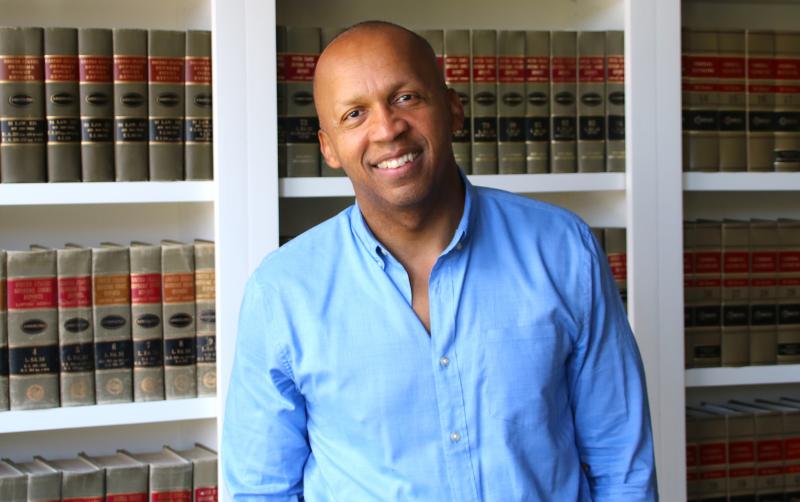Bryan Stevenson: Milton native leads fight to challenge past, shape future
The morning following a concert when he introduced music legend Stevie Wonder to a thrilled crowd, Bryan Stevenson said that in 1989, when he started the Equal Justice Initiative, he never imagined the work would bring him so far.
“They were like [Bryan], ‘Stevie would like you to introduce him,’” said Stevenson, a Cape Henlopen High School graduate who grew up near Milton, speaking in an EJI conference room about the moment right before Wonder was about to make a surprise performance. “I’m standing on stage thinking, am I really doing this? I got to talk with Stevie for about an hour before he performed. He’s such a beautiful human being.”
Held April 27 at Montgomery’s Riverwalk Amphitheater, the Concert for Peace and Justice culminated three days of celebration for the grand opening of the EJI’s Legacy Museum, the National Memorial for Peace and Justice and a two-day Peace and Justice Summit, which shed light on issues facing people of color in the United States.
During an April 28 interview in an EJI conference, Stevenson said he’s not a coffee drinker, but he had four cups of tea that morning to help keep him moving and to help save his voice.
“It’s been pretty exhausting. I’ll get a chance to rest soon,” he said with an I-don’t-ever-really-rest smile.
The Equal Justice Initiative is a nonprofit committed to ending mass incarceration and excessive punishment in the United States. For the better part of three decades, the organization has challenged racial and economic injustice and fought to protect basic human rights for the most vulnerable people in America.
Located in a building in Montgomery where enslaved people had been warehoused, the Legacy Museum guides visitors through the sights and sounds of the domestic slave trade, racial terrorism, the Jim Crow South and the world’s largest prison system.
The National Memorial for Peace and Justice sits on a 6-acre hill overlooking downtown Montgomery, and uses sculpture, art and design to tell the story of racial terror. At its center, the memorial square, stand 800 steel monuments, 6-feet-tall, symbolizing thousands of lynchings in the United States. Each monument is engraved with the name of a person who was lynched and the county and state where it occurred.
Stevenson said he hopes the museum and the memorial will spark a conversation. “We’ve been silent about our history for too long,” he said.
Delaware makes an appearance on the engraved memorials. EJI documents one lynching: George White, June 22, 1903, New Castle County.
As a Milton native, Stevenson said Sussex County is in the South; the people of Sussex have experienced the same racial discrimination issues that continue in other parts of the South. He said his first year of schooling was in a colored school in Milton.
“It’s a part of Sussex history that’s not addressed enough,” he said.
Stevenson said his family – an older brother, younger sister and parents – was essential to his upbringing, supporting each other through life’s early challenges.
“My siblings and I were really close,” he said. “Growing up in the sticks of Milton, family becomes your world.”
Over the years, that world has expanded. Stevenson can now include the likes of the Rev. Jesse Jackson, activist Ruby Sales, activist Sen. John Lewis and many other founders of the civil rights movement as friends and mentors. During the opening ceremony of the museum and memorial April 26, Stevenson described these people as civil rights royalty. It was clear by their reaction, that royalty was ushering Stevenson in as its next member.
Stevenson said it is affirming to have received their generous support. “It’s an honor to continue fighting the work they started,” he said.
Stevenson said it’s hard to believe how the Equal Justice Initiative has grown. There are now 80 employees, and it’s working harder than ever to make sure unfair cultural institutions will not live on.
“It’s very exciting,” he said.
Looking forward, Stevenson said EJI will continue to fight for those who have been wrongfully convicted and will continue to facilitate a frank conversation about the history of slavery, racial terror lynchings and mass incarceration in the United States. In addition, he said the organization will look at how the disabled are treated in the justice system and will represent children who have been unfairly sentenced.
The nation has a Disabilities Act that protects individual rights in many areas of life, he said, except it’s not enforced in the criminal justice system. EJI has grown increasingly concerned about the cruel and unusual punishment these people are facing, he said.
“We’re going to be looking to challenge those types of things,” Stevenson said.
Stevenson said he appreciates all the notoriety the museum and memorial have brought, but with a shrug of the shoulders, he said he doesn’t need the acclaim. People have been very critical and had harsh words over the years, he said.
“It’s about the work. It’s about doing better for the people who are incarcerated,” Stevenson said. “The reward is in seeing those changes.”
Stevenson family out in full force
Stevenson estimated close to 10,000 people attended the memorial and museum opening events. Among them was a contingent of family and friends from Delaware that numbered near 50.
Dr. Howard Stevenson, Bryan’s older brother by a little more than a year, is a professor at the Graduate School of Education at the University of Pennsylvania, also known locally as a member of the Cape Henlopen High School basketball team that won back-to-back state championships in the 1970s. He said his brother’s work is changing the narrative on the story of racial terrorism in the United States.
“It’s a fundamental fact that black and brown people have been systematically disenfranchised,” said Howard, who described Bryan as his best friend growing up.
Howard said their parents provided two different examples of how to deal with racial inequalities growing up in Sussex County. Dad, he said, was more like Martin Luther King Jr. Mom, on the other hand, was more like Malcolm X, he said.
“Bryan fights the way my mother fought,” said Howard.
Christy Taylor, the youngest of the three siblings by a little less than a year, still lives near Milton. She’s on her way to getting her doctorate, and she said she plans to open a charter school in Delaware in honor of Bryan.
She said she was impressed with the respect that national and international celebrities have shown Bryan.
He’s so modest, she said. “If it were me, I’d be wearing a T-shirt saying I was Bryan Stevenson,” she said laughing. “That’s why he was chosen to be a leader.”
She said growing up, Bryan would be inside reading huge books, but then he’d also go out and play. He’s so normal in many respects, she said.
She said the experience in Montgomery was emotional. She said she was trying to control her tears, but it was challenging.
“There’s been this feeling of a warm blanket of my mother over him,” she said. “There’s been a generational passing of the torch of love.”
Amy Shepherd, Bryan’s second cousin from Middletown and a school librarian, attended with her two daughters, Savannah and Julianna, and her sister Tammi Stephens.
As an educator, Shepherd said, she brought her daughters to Montgomery to learn about the country’s past. It’s historic, she said.
Julianna, 12, said she was inspired by what she saw and is going to ask her principal to see if her school can teach the history of slavery and mass incarceration at a much deeper level.
“Let us talk more about slavery, so we don’t repeat it,” Julianna said.
Savannah, 15, said the experience changed her perspective. She now wants to get more involved with EJI moving forward.
“I want to make a difference,” Savannah said.
Chris Flood has been working for the Cape Gazette since early 2014. He currently covers Rehoboth Beach and Henlopen Acres, but has also covered Dewey Beach and the state government. He covers environmental stories, business stories and random stories on subjects he finds interesting, and he also writes a column called Choppin’ Wood that runs every other week. He’s a graduate of the University of Maine and the Landing School of Boat Building & Design.



















































